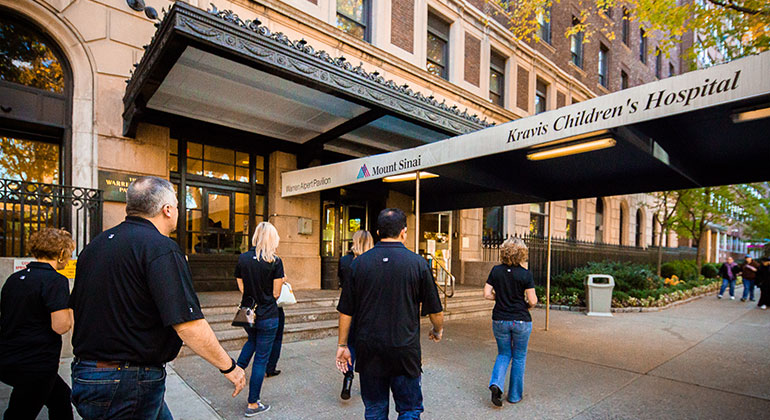Mount Sinai Kravis Children’s Hospital Is First in Manhattan to Use Cutting-Edge Seizure Monitoring Technology for Critically Ill Children

Mount Sinai Kravis Children’s Hospital will be the first children’s hospital in Manhattan to use a new, state-of-the art seizure monitoring device that facilitates rapid, point-of-care detection and diagnosis of non-convulsive seizure activity in critically ill children to ensure they receive optimal treatment as quickly as possible.
Until now, this technology, known as the Ceribell Rapid Response device, has only been available to adult patients at The Mount Sinai Hospital. It consists of a small headband with electrodes and a small recording device that can be transported easily within the hospital setting. Being portable and relatively easy to operate, it can be set up and used within minutes. The device will be available to pediatric patients starting on Thursday, April 7.
“We are very pleased to bring this advanced technology to Mount Sinai Kravis Children’s Hospital to provide the most up-to-date, highest-quality, and safest care for our young patients,” says Sandeep Gangadharan, MD, Associate Professor of Pediatrics at the Icahn School of Medicine at Mount Sinai and Medical Director of Pediatric Critical Care at Mount Sinai Kravis Children’s Hospital. “This new addition to our critical care units will not only benefit our pediatric patients with seizure disorders, but also those who have experienced other neurological injuries or surgery, as well as children who have undergone cardiac surgery.”
Non-convulsive seizures (NCS), which include non-convulsive status epilepticus (NCSE), are prolonged seizures among both pediatric and adult patients who are critically ill. Their detection can be challenging because they occur with minimal outward clinical signs; in contrast, convulsive seizures are less difficult for the emergency department or ICU clinicians to recognize.
The availability of this new technology at the bedside in the Pediatric Intensive Care Unit (PICU) and Pediatric Cardiac Intensive Care Unit (PCICU) will allow Mount Sinai clinicians to detect and treat non-convulsive seizures within as few as five minutes.
“In critically ill patients, the technology of electroencephalography, or EEG, for monitoring is integral to detection, and every minute counts. The urgency to both detect and treat a seizure within 30 minutes to protect the brain in both adults and young children has been very well documented in medical literature,” says Maite La Vega-Massello, MD, Assistant Professor of Neurology, and Pediatrics, at Icahn Mount Sinai, who is Interim Director of the Pediatric Epilepsy Monitoring Unit at Kravis Children’s Hospital. “This new technology provides a rapid way to diagnose the pediatric patient and removes the waiting time and dependence on trained technician availability that’s associated with the standard EEG machine.”
The occurrence of electrographic seizures among children in the pediatric ICU, particularly those with known risk factors, has been well documented, with concern that mortality associated with these seizures remains a serious risk. When non-convulsive status epilepticus (NCSE) is suspected, the Neurocritical Care Society recommends continuous EEG to be initiated within 15-60 minutes, underlining the urgency of every minute. The most recent American Heart Association guidelines require EEG to be promptly performed for the diagnosis of seizures in all patients who are comatose following cardiac arrest.
“This new technology will greatly improve our capacity to care for pediatric patients in an urgent setting like the PICU and PCICU where time is of the essence,” says Toni Kavanagh, CNRN, MSHA, Pediatric Neurology Nurse Specialist at Mount Sinai Kravis Children’s Hospital. “It allows more urgent triage capability so we can diagnose sub-clinical seizure activity early and ensure proper treatment. An important benefit of this technology is that it will also help avoid unnecessary treatment and unneeded medications through timely and accurate diagnosis.”
About the Mount Sinai Health System
Mount Sinai Health System is one of the largest academic medical systems in the New York metro area, with 48,000 employees working across seven hospitals, more than 400 outpatient practices, more than 600 research and clinical labs, a school of nursing, and a leading school of medicine and graduate education. Mount Sinai advances health for all people, everywhere, by taking on the most complex health care challenges of our time—discovering and applying new scientific learning and knowledge; developing safer, more effective treatments; educating the next generation of medical leaders and innovators; and supporting local communities by delivering high-quality care to all who need it.
Through the integration of its hospitals, labs, and schools, Mount Sinai offers comprehensive health care solutions from birth through geriatrics, leveraging innovative approaches such as artificial intelligence and informatics while keeping patients’ medical and emotional needs at the center of all treatment. The Health System includes approximately 9,000 primary and specialty care physicians and 10 free-standing joint-venture centers throughout the five boroughs of New York City, Westchester, Long Island, and Florida. Hospitals within the System are consistently ranked by Newsweek’s® “The World’s Best Smart Hospitals, Best in State Hospitals, World Best Hospitals and Best Specialty Hospitals” and by U.S. News & World Report's® “Best Hospitals” and “Best Children’s Hospitals.” The Mount Sinai Hospital is on the U.S. News & World Report® “Best Hospitals” Honor Roll for 2025-2026.
For more information, visit https://www.mountsinai.org or find Mount Sinai on Facebook, Instagram, LinkedIn, X, and YouTube.